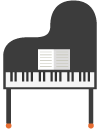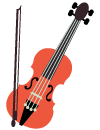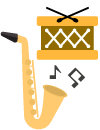Introduction
Piano

The piano major is led by talented educators who are recipients of awards from foreign musical competitions and are active in piano performance. In order to build a strong musical foundation, sightreading, music dictation, harmonics, counterpoint, music analysis, and music history along are all required courses in the curriculum.
Performance classes and recitals, which are held in the spring and fall, are offered in order to provide students opportunities for public performance. In order to provide further experience, foreign professors are invited to teach master classes. Not only is solo performance considered to be important but playing as an accompanist and as part of an ensemble is also considered to be important as well and thus courses in instrumental accompaniment, vocal accompaniment and chamber music ensemble classes are subsequently offered.
String

In the strings program, students study the violin, viola, cello, double bass, guitar, and harp, and are trained to pursue their careers not only in Korea, but also all over the world. Bachelor’s, Master’s, and doctoral degrees are offered in this program.
During a student's four years of undergraduate studies, every semester's curriculum includes core courses that are required. The core courses range from the Baroque period music to today’s modern music. In addition, students are also required to take string ensemble courses, orchestral classes, and chamber music classes. These courses are designed to prepare students for the world of orchestral and ensemble performance. In order to further prepare students, on many occasions, first chairs from a variety of orchestras will educate students in orchestra repertoire. Students not only study instruments of their own major but also study other areas of music such as the history of Western music, musical analysis, harmonics, counterpoint, sightreading, music dictation as part of their required core major coursework.
During the four semesters of graduate studies, twenty six or more credit hours are required. Furthermore, doctoral candidates are required to complete forty or more credit hours during six semesters. They are required to study the instrument of their major, ensemble work, and advanced theory.
Wind

The Department of Wind Instruments includes woodwind, brass, and percussion instruments. In order to train students to become fluent performers, Professors Young Rhyul Kim (horn) and Kyoung Hwan Choi (percussion) along with other famous performing educators teach the students the correct posture for performing, breathing techniques, and resonance techniques. They also teach orchestral studies as well as performance for the instruments in their area of specialization in order for students to become talented performers. In order to further develop their performance techniques, students participate and perform in different ensembles and master classes.
In 1961, a wind ensemble group was formed at Seoul National University. Today, a concert is held annually as well as numerous project concerts, television performances, and other concerts held in major cities across Korea. It is through these performances that students obtain experience in performing and thus develop proficiency in their repertoires. The Seoul National University Wind Ensemble is known for its unique sound as well as its superb harmony and has received outstanding reviews.
In 1999, Professors Hye Sun Baek and Hyung Joon Jang performed with the wind ensemble, which resulted in a recording and a CD release. The CD focused on an academic repertoire and featured a brilliant performance which has since been broadcasted frequently. In 2001, a concert headlining the highlights of Verdi's opera, La Traviatta was held and showed the public that a wind ensemble was capable of performing music that was written for orchestras. Donald Hunsberger, the conductor for the Eastman Wind Ensemble for the past forty years, conducted a concert for the wind ensemble performance in 2002, where Strauss' works for wind ensembles and, contemporary works by Milhaud and Malcolm Arnold were performed. It was for this performance that national recognition was given for the further development of wind ensembles.

